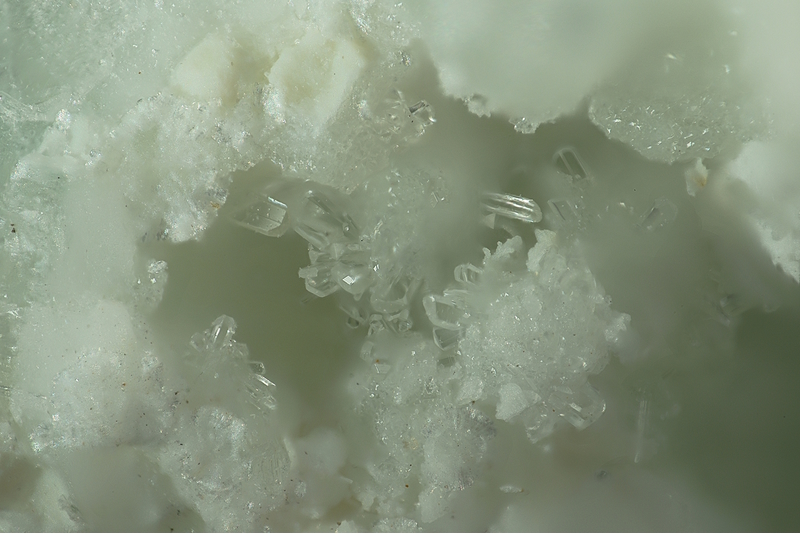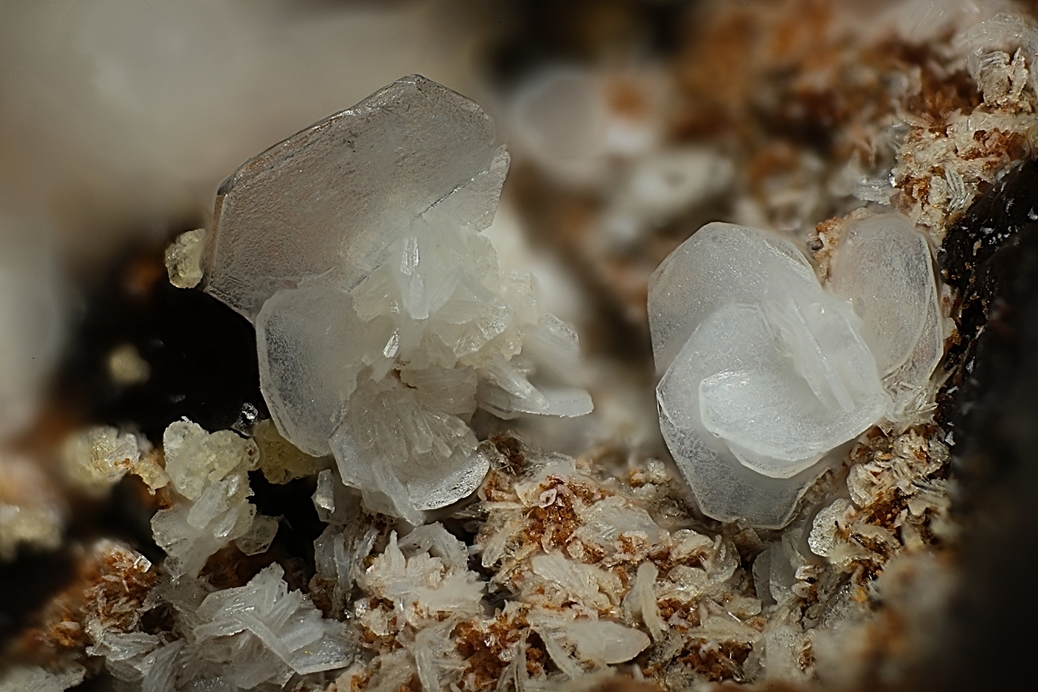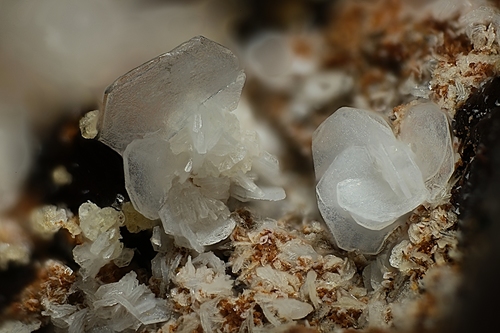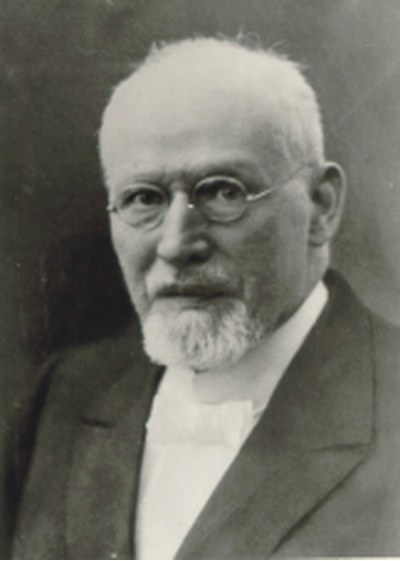Vaterite
A valid IMA mineral species - grandfathered
This page is currently not sponsored. Click here to sponsor this page.
About Vaterite
Formula:
CaCO3
Colour:
Colorless
Lustre:
Sub-Vitreous, Waxy
Hardness:
3
Specific Gravity:
2.645
Crystal System:
Hexagonal
Name:
Named in honor of Heinrich August Vater [September 5, 1859 Bremen, Germany - February 10, 1930 Dresden, Germany], Professor of Mineralogy and Chemistry, Tharandt, Saxony (Germany). He was a pioneer in the areas of forest soil science, land evaluation, and forest fertilization.
Polymorph of:
A rare CaCO3 modification that is metastable below approx. 400°C. May be stabilised by sulphate (Fernández-Díaz et al., 2010).
Vaterite is actually composed of at least two different crystallographic structures that coexist within a pseudo–single crystal. The major structure (actually substructure) exhibits hexagonal symmetry; the minor structure, existing as nanodomains within the major matrix, is still unknown (Kabalah-Amitai et al., 2013). However, as suggested by Christy (2017) in his review, the most plausible polytypes to describe the structure, namely the 2M and 6H ones, actually "do not occur in their highest-symmetry forms", but are described by the space groups C121 and P3221, respectively.
The structure is disordered in terms of (1) different orientations of the carbonate groups, (2) different stacking sequences of the carbonate-comprising layers, and (3) possible chiral forms (Demichelis et al., 2013). The OD character leads to polytypism; the OD layer comprises Ca coordination polyhedra and halves of the carbonate groups, and the group symmetry of the layer is C2/m; the known stacking sequences include: P6122, P6522, C2/c, C2/c2/m21/m, and P312 or P322. The type of the OD layering is similar to those observed in bastnäsite-synchysite polysomatic series (Makovicky, 2016).
Not uncommon as a biomineral (other sources: rarely used in hard tissue). Exists in fish otoliths. As such, it is formed from the precursor - Unnamed (Amorphous Calcium Carbonate) - via dehydration (Bots et al., 2012), the transformation process being inhibited in the presence of PO43- ions (Sugiura et al., 2016). Further dissolution-reprecipitation turns vaterite into calcite. Vaterite/calcite precipitates are known in the Cladosporium fungus, too (Ye et al., 2023).
May comprise a series with bästnasite group, known as bästnasite-vaterite homologous series.
Vaterite is actually composed of at least two different crystallographic structures that coexist within a pseudo–single crystal. The major structure (actually substructure) exhibits hexagonal symmetry; the minor structure, existing as nanodomains within the major matrix, is still unknown (Kabalah-Amitai et al., 2013). However, as suggested by Christy (2017) in his review, the most plausible polytypes to describe the structure, namely the 2M and 6H ones, actually "do not occur in their highest-symmetry forms", but are described by the space groups C121 and P3221, respectively.
The structure is disordered in terms of (1) different orientations of the carbonate groups, (2) different stacking sequences of the carbonate-comprising layers, and (3) possible chiral forms (Demichelis et al., 2013). The OD character leads to polytypism; the OD layer comprises Ca coordination polyhedra and halves of the carbonate groups, and the group symmetry of the layer is C2/m; the known stacking sequences include: P6122, P6522, C2/c, C2/c2/m21/m, and P312 or P322. The type of the OD layering is similar to those observed in bastnäsite-synchysite polysomatic series (Makovicky, 2016).
Not uncommon as a biomineral (other sources: rarely used in hard tissue). Exists in fish otoliths. As such, it is formed from the precursor - Unnamed (Amorphous Calcium Carbonate) - via dehydration (Bots et al., 2012), the transformation process being inhibited in the presence of PO43- ions (Sugiura et al., 2016). Further dissolution-reprecipitation turns vaterite into calcite. Vaterite/calcite precipitates are known in the Cladosporium fungus, too (Ye et al., 2023).
May comprise a series with bästnasite group, known as bästnasite-vaterite homologous series.
Unique Identifiers
Mindat ID:
4161
Long-form identifier:
mindat:1:1:4161:0
GUID
(UUID V4):
(UUID V4):
63facd26-2fc7-4d0e-b1f1-ded8df6e92d4
IMA Classification of Vaterite
Approved, 'Grandfathered' (first described prior to 1959)
IMA Formula:
Ca(CO3)
Classification of Vaterite
5.AB.20
5 : CARBONATES (NITRATES)
A : Carbonates without additional anions, without H2O
B : Alkali-earth (and other M2+) carbonates
5 : CARBONATES (NITRATES)
A : Carbonates without additional anions, without H2O
B : Alkali-earth (and other M2+) carbonates
14.1.2.1
14 : ANHYDROUS NORMAL CARBONATES
1 : A(XO3)
14 : ANHYDROUS NORMAL CARBONATES
1 : A(XO3)
11.4.3
11 : Carbonates
4 : Carbonates of Ca
11 : Carbonates
4 : Carbonates of Ca
Mineral Symbols
As of 2021 there are now IMA–CNMNC approved mineral symbols (abbreviations) for each mineral species, useful for tables and diagrams.
Please only use the official IMA–CNMNC symbol. Older variants are listed for historical use only.
Please only use the official IMA–CNMNC symbol. Older variants are listed for historical use only.
| Symbol | Source | Reference |
|---|---|---|
| Vtr | IMA–CNMNC | Warr, L.N. (2021). IMA–CNMNC approved mineral symbols. Mineralogical Magazine, 85(3), 291-320. doi:10.1180/mgm.2021.43 |
| Vtr | Whitney & Evans (2010) | Whitney, D.L. and Evans, B.W. (2010) Abbreviations for names of rock-forming minerals. American Mineralogist, 95, 185–187 doi:10.2138/am.2010.3371 |
Physical Properties of Vaterite
Sub-Vitreous, Waxy
Transparency:
Transparent
Colour:
Colorless
Streak:
White
Hardness:
3 on Mohs scale
Tenacity:
Brittle
Fracture:
Irregular/Uneven, Splintery
Density:
2.645 g/cm3 (Measured) 2.645 g/cm3 (Calculated)
Optical Data of Vaterite
Type:
Uniaxial (+)
RI values:
nω = 1.550 nε = 1.650
Birefringence:
0.10
Max Birefringence:
δ = 0.100

Image shows birefringence interference colour range (at 30µm thickness)
and does not take into account mineral colouration.
and does not take into account mineral colouration.
Surface Relief:
Moderate
Optical Extinction:
Parallel
Chemistry of Vaterite
Mindat Formula:
CaCO3
Elements listed:
CAS Registry number:
Crystallography of Vaterite
Crystal System:
Hexagonal
Class (H-M):
6/mmm (6/m 2/m 2/m) - Dihexagonal Dipyramidal
Space Group:
P63/mmc
Cell Parameters:
a = 4.13 Å, c = 8.49 Å
Ratio:
a:c = 1 : 2.056
Unit Cell V:
125.41 ų (Calculated from Unit Cell)
Z:
6
Morphology:
Thin fibers, spherulitic aggregates.
Comment:
Wang, J.W. & Becker, U. (2009): Structure and carbonate orientation of vaterite (CaCO3). Am. Mineral. 94, 380-386. Important note: Christy (2017) actually suggests, that the correct space groups to describe the polytypes constituting the vaterite crystals are C121 (monoclinic crystal system) and P3221 (trigonal crystal system)
Crystal Structure
Load
Unit Cell | Unit Cell Packed
2x2x2 | 3x3x3 | 4x4x4
Unit Cell | Unit Cell Packed
2x2x2 | 3x3x3 | 4x4x4
Show
Big Balls | Small Balls | Just Balls | Spacefill
Polyhedra Off | Si Polyhedra | All Polyhedra
Remove metal-metal sticks
Big Balls | Small Balls | Just Balls | Spacefill
Polyhedra Off | Si Polyhedra | All Polyhedra
Remove metal-metal sticks
Display Options
Black Background | White Background
Perspective On | Perspective Off
2D | Stereo | Red-Blue | Red-Cyan
Black Background | White Background
Perspective On | Perspective Off
2D | Stereo | Red-Blue | Red-Cyan
View
CIF File Best | x | y | z | a | b | c
CIF File Best | x | y | z | a | b | c
Rotation
Stop | Start
Stop | Start
Labels
Console Off | On | Grey | Yellow
Console Off | On | Grey | Yellow
Data courtesy of the American Mineralogist Crystal Structure Database. Click on an AMCSD ID to view structure
| ID | Species | Reference | Link | Year | Locality | Pressure (GPa) | Temp (K) |
|---|---|---|---|---|---|---|---|
| 0004854 | Vaterite | Wang J, Becker U (2009) Structure and carbonate orientation of vaterite (CaCO3) American Mineralogist 94 380-386 |  | 2009 | theoretical | 0 | 293 |
| 0009279 | Vaterite | Kamhi S R (1963) On the structure of vaterite, CaCO3 Acta Crystallographica 16 770-772 |  | 1963 | Synthetic, preferred structure model | 0 | 293 |
| 0019139 | Vaterite | Meyer H J (1959) Uber Vaterit und seine Struktur Angewandte Chemie 71 678-679 | 1959 | 0 | 293 | ||
| 0019869 | Vaterite | Demichelis R, Raiteri P, Gale J D, Dovesi R (2012) A new structural model for disorder in vaterite from first-principles calculations CrystEngComm 14 44-47 | 2012 | theoretical | 0 | 293 | |
| 0019870 | Vaterite | Demichelis R, Raiteri P, Gale J D, Dovesi R (2012) A new structural model for disorder in vaterite from first-principles calculations CrystEngComm 14 44-47 | 2012 | theoretical | 0 | 293 | |
| 0019871 | Vaterite | Demichelis R, Raiteri P, Gale J D, Dovesi R (2012) A new structural model for disorder in vaterite from first-principles calculations CrystEngComm 14 44-47 | 2012 | theoretical | 0 | 293 | |
| 0019872 | Vaterite | Demichelis R, Raiteri P, Gale J D, Dovesi R (2012) A new structural model for disorder in vaterite from first-principles calculations CrystEngComm 14 44-47 | 2012 | theoretical | 0 | 293 | |
| 0019865 | Vaterite | Demichelis R, Raiteri P, Gale J D, Dovesi R (2013) The multiple structures of vaterite Crystal Growth & Design 13 2247-2251 | 2013 | theoretical | 0 | 293 | |
| 0019866 | Vaterite | Demichelis R, Raiteri P, Gale J D, Dovesi R (2013) The multiple structures of vaterite Crystal Growth & Design 13 2247-2251 | 2013 | theoretical | 0 | 293 | |
| 0019867 | Vaterite | Demichelis R, Raiteri P, Gale J D, Dovesi R (2013) The multiple structures of vaterite Crystal Growth & Design 13 2247-2251 | 2013 | theoretical | 0 | 293 | |
| 0019868 | Vaterite | Demichelis R, Raiteri P, Gale J D, Dovesi R (2013) The multiple structures of vaterite Crystal Growth & Design 13 2247-2251 | 2013 | theoretical | 0 | 293 | |
| 0019019 | Vaterite | Le Bail A, Ouhenia S, Chateigner D (2011) Microtwinning hypothesis for a more ordered vaterite model Powder Diffraction 26 16-21 | 2011 | synthetic | 0 | 293 | |
| 0019140 | Vaterite | Le Bail A, Ouhenia S, Chateigner D (2011) Microtwinning hypothesis for a more ordered vaterite model Powder Diffraction 26 16-21 | 2011 | synthetic | 0 | 293 | |
| 0019141 | Vaterite | Le Bail A, Ouhenia S, Chateigner D (2011) Microtwinning hypothesis for a more ordered vaterite model Powder Diffraction 26 16-21 | 2011 | synthetic | 0 | 293 |
CIF Raw Data - click here to close
X-Ray Powder Diffraction
Powder Diffraction Data:
| d-spacing | Intensity |
|---|---|
| 3.57 Å | (55) |
| 3.30 Å | (100) |
| 2.73 Å | (95) |
| 2.065 Å | (60) |
| 1.858 Å | (25) |
| 1.823 Å | (70) |
| 1.647 Å | (25) |
Comments:
See also 33-268; 13-192 (synthetic)
Geological Environment
Paragenetic Mode(s):
| Paragenetic Mode | Earliest Age (Ga) |
|---|---|
| Near-surface Processes | |
| 23 : Subaerial aqueous alteration by non-redox-sensitive fluids (see also #47) | |
| Stage 5: Initiation of plate tectonics | <3.5-2.5 |
| 40 : Regional metamorphism (greenschist, amphibolite, granulite facies) | |
| Stage 10a: Neoproterozoic oxygenation/terrestrial biosphere | <0.6 |
| 49 : Oxic cellular biomineralization (see also #44) | <0.54 |
| 51 : Pyrometamorphic minerals (see also #54 and #56) | <0.36 |
Synonyms of Vaterite
Other Language Names for Vaterite
Relationship of Vaterite to other Species
Forms a series with:
Common Associates
Associated Minerals Based on Photo Data:
| 6 photos of Vaterite associated with Monohydrocalcite | CaCO3 · H2O |
| 5 photos of Vaterite associated with Rasvumite | KFe2S3 |
| 3 photos of Vaterite associated with Afwillite | Ca3(HSiO4)2 · 2H2O |
| 2 photos of Vaterite associated with Shortite | Na2Ca2(CO3)3 |
| 1 photo of Vaterite associated with Portlandite | Ca(OH)2 |
| 1 photo of Vaterite associated with Periclase | MgO |
| 1 photo of Vaterite associated with Spurrite | Ca5(SiO4)2(CO3) |
| 1 photo of Vaterite associated with Mckinstryite | Ag5-xCu3+xS4 |
| 1 photo of Vaterite associated with Andradite | Ca3Fe3+2(SiO4)3 |
| 1 photo of Vaterite associated with Halite | NaCl |
Related Minerals - Strunz-mindat Grouping
| 5.AB.05 | Calcite | CaCO3 |
| 5.AB.05 | Gaspéite | NiCO3 |
| 5.AB.05 | Magnesite | MgCO3 |
| 5.AB.05 | Otavite | CdCO3 |
| 5.AB.05 | Rhodochrosite | MnCO3 |
| 5.AB.05 | Siderite | FeCO3 |
| 5.AB.05 | Smithsonite | ZnCO3 |
| 5.AB.05 | Spherocobaltite | CoCO3 |
| 5.AB.05 va | Parakutnohorite | |
| 5.AB.10 | Ankerite | Ca(Fe2+,Mg)(CO3)2 |
| 5.AB.10 | Dolomite | CaMg(CO3)2 |
| 5.AB.10 | Kutnohorite | CaMn2+(CO3)2 |
| 5.AB.10 | Minrecordite | CaZn(CO3)2 |
| 5.AB.10 | Škáchaite | CaCo(CO3)2 |
| 5.AB.15 | Aragonite | CaCO3 |
| 5.AB.15 | Cerussite | PbCO3 |
| 5.AB.15 | Strontianite | SrCO3 |
| 5.AB.15 | Witherite | BaCO3 |
| 5.AB.25 | Huntite | CaMg3(CO3)4 |
| 5.AB.30 | Norsethite | BaMg(CO3)2 |
| 5.AB.35 | Alstonite | BaCa(CO3)2 |
| 5.AB.40 | Olekminskite | Sr(Sr,Ca,Ba)(CO3)2 |
| 5.AB.40 | Paralstonite | BaCa(CO3)2 |
| 5.AB.45 | Barytocalcite | BaCa(CO3)2 |
| 5.AB.50 | Carbocernaite | (Ca,Na)(Sr,Ce,Ba)(CO3)2 |
| 5.AB.55 | Benstonite | Ba6Ca6Mg(CO3)13 |
| 5.AB.60 | Juangodoyite | Na2Cu(CO3)2 |
Fluorescence of Vaterite
Not known to fluoresce.
Other Information
Thermal Behaviour:
Dry crystals convert to calcite when heated to about 440°.
Notes:
Converts to aragonite or calcite when boiled in water. Converts to calcite when boiled in NaCl solution.
Health Risks:
No information on health risks for this material has been entered into the database. You should always treat mineral specimens with care.
Internet Links for Vaterite
mindat.org URL:
https://www.mindat.org/min-4161.html
Please feel free to link to this page.
Please feel free to link to this page.
Search Engines:
External Links:
Mineral Dealers:
References for Vaterite
Reference List:
forum.amiminerals.it (n.d.) http://forum.amiminerals.it/viewtopic.php?f=5&t=18832&sid=e8aae49190826b910b22d665e6ff58fa
Meigen, W. (1911) Über kohlensauren Kalk. Verhandl. Ges. Deut. Naturforscher u. Ärtzte, 82, 120-124.
Localities for Vaterite
Locality List
 - This locality has map coordinates listed.
- This locality has map coordinates listed.
 - This locality has estimated coordinates.
ⓘ - Click for references and further information on this occurrence.
? - Indicates mineral may be doubtful at this locality.
- This locality has estimated coordinates.
ⓘ - Click for references and further information on this occurrence.
? - Indicates mineral may be doubtful at this locality.
 - Good crystals or important locality for species.
- Good crystals or important locality for species.
 - World class for species or very significant.
(TL) - Type Locality for a valid mineral species.
(FRL) - First Recorded Locality for everything else (eg varieties).
- World class for species or very significant.
(TL) - Type Locality for a valid mineral species.
(FRL) - First Recorded Locality for everything else (eg varieties).
All localities listed without proper references should be considered as questionable.
Antarctica | |
| Browne |
Australia | |
| Bottrill et al. (2008) |
Austria | |
| 42 +2 other references |
Canada | |
| Gleeson et al. (2011) |
| HORVÁTH et al. (2000) +1 other reference |
| Fournier (1993) |
| FOURNIER (1993) | |
France | |
| publication date: November 2018 +1 other reference |
Germany | |
| Walenta (1995) |
| Schnorrer-Köhler (1991) |
| Hentschel et al. (1983) |
| Hentschel (1983) |
| [Hentschel et al. (5) |
| Schüller et al. (1986) |
| Hentschel (1983) |
Hungary | |
| Szakáll & Gatter: Hun. Min. Spec. |
Italy | |
| Pavel M. Kartashov analytical data |
Japan | |
| Ito et al. (1999) |
Jordan | |
| Pitty et al. (2010) |
| Khoury et al. (1985) |
Kyrgyzstan | |
| Shevkunov et al. (2022) |
Lebanon | |
| Kruszewski et al. (South Lebanon) |
Middle East | |
| Gross (1977) | |
Namibia | |
| ex J Lamond Micro Collection (ex Rob Sielecki) |
New Zealand | |
| Newman (2015) |
| Black |
Palestine | |
| Sokol et al. (2011) |
| Shulamit Gross (1977) |
Poland | |
| Kruszewski L. 2006: Oldhamite-periclase-portlandite-fluorite assemblage and coexisting minerals of burnt dump in Siemianowice Śląskie - Dąbrówka Wielka area (Upper Silesia, Poland) |
Romania | |
| Szakáll |
| Szakáll et al. (2010) | |
| D. Dumitras (2000) +1 other reference |
Russia | |
| Cesnokov et al. (1998) |
| ... |
| Belovitskaya et al. (2004) |
Slovakia | |
| Mikuš T. et al. (2017) |
| Mikuš T. et al. (in Slovak with English abstract) | |
South Africa | |
| Cairncross et al. (1995) |
UK | |
| Field et al. (2016) +1 other reference |
| McConnell (1960) +1 other reference |
USA | |
| Anthony et al. (1995) |
| Excalibur Mineral Company specimen |
| Heinrich et al. (2004) |
| XRD - Laszlo Horvath collection |
| www.excaliburmineral.com |
Quick NavTopAbout VateriteUnique IdentifiersIMA Classification Classification Mineral SymbolsPhysical Properties Optical Data Chemistry Crystallography Crystal StructureX-Ray Powder DiffractionGeological EnvironmentSynonymsOther LanguagesRelationshipsCommon AssociatesStrunz-MindatFluorescence Other InformationInternet Links References Localities Locality List






 symbol to view information about a locality.
The
symbol to view information about a locality.
The 



San Vito Quarry, San Vito, Ercolano, Mount Somma, Somma-Vesuvius Complex, Naples, Campania, Italy